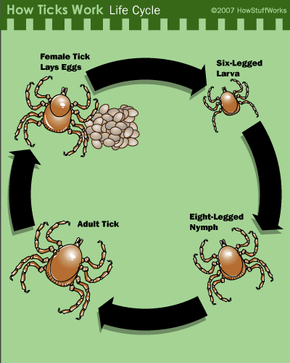Tick Life Cycles
You probably have a clear idea of what happens to a person or an animal if it doesn't get food -- it starves to death. Ticks can also starve to death, but often the process takes months or even years. However, without food, ticks can't do much. Ticks are a clear illustration of how food works as an energy source. Ticks need energy from blood in order to grow, develop and lay eggs. Without blood, ticks can't do any of this.
A tick begins its life as an egg. When the egg hatches, a six-legged larva emerges. Aside from its missing set of legs, the larva looks a lot like an adult tick. Its first host is usually a small mammal or a lizard, and it has to find a host in order to grow. After feeding, the larva drops to the ground to digest its food and begin to grow. After one to three weeks, the larva molts and becomes a nymph.
Advertisement
A tick nymph has eight legs and looks like a smaller version of an adult tick. It has to find another meal, usually from another small mammal, bird or lizard, before it can molt again. Once the nymph is finished eating, it drops to the ground to continue its development. Some species of soft tick molt several times, consuming a blood meal before each molt. After its final molt, the tick is an adult.

An adult tick has one job -- to reproduce. In hard ticks, the female tick attaches to a host and feeds, often for more than 24 hours, before mating. The male tick feeds before mating as well, but he's often a fraction of the size of the engorged female when mating takes place. Often, the male dies after mating, and the female dies after laying anywhere from 2,000 to 18,000 eggs. Soft ticks are an exception. Many species of soft tick eat several smaller blood meals and lay eggs several times. This is one reason soft ticks don't consume as much blood in one sitting or swell to the extent that hard ticks do.
Hard and soft ticks also have different methods for finding hosts, which we'll examine in the next section.
